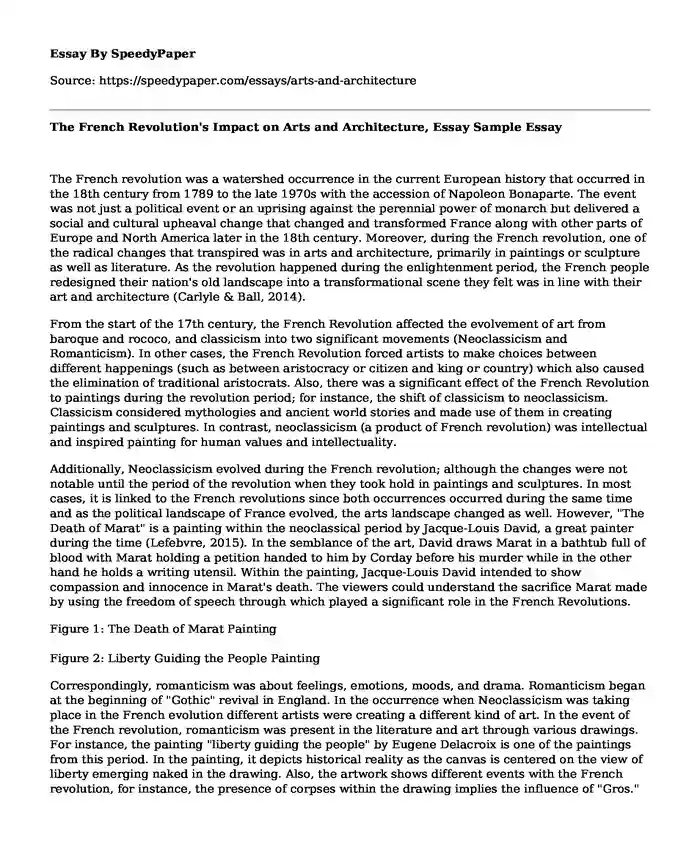
| Type of paper: | Essay |
| Categories: | Architecture Art French Revolution Napoleon |
| Pages: | 3 |
| Wordcount: | 662 words |
The French revolution was a watershed occurrence in the current European history that occurred in the 18th century from 1789 to the late 1970s with the accession of Napoleon Bonaparte. The event was not just a political event or an uprising against the perennial power of monarch but delivered a social and cultural upheaval change that changed and transformed France along with other parts of Europe and North America later in the 18th century. Moreover, during the French revolution, one of the radical changes that transpired was in arts and architecture, primarily in paintings or sculpture as well as literature. As the revolution happened during the enlightenment period, the French people redesigned their nation's old landscape into a transformational scene they felt was in line with their art and architecture (Carlyle & Ball, 2014).
From the start of the 17th century, the French Revolution affected the evolvement of art from baroque and rococo, and classicism into two significant movements (Neoclassicism and Romanticism). In other cases, the French Revolution forced artists to make choices between different happenings (such as between aristocracy or citizen and king or country) which also caused the elimination of traditional aristocrats. Also, there was a significant effect of the French Revolution to paintings during the revolution period; for instance, the shift of classicism to neoclassicism. Classicism considered mythologies and ancient world stories and made use of them in creating paintings and sculptures. In contrast, neoclassicism (a product of French revolution) was intellectual and inspired painting for human values and intellectuality.
Additionally, Neoclassicism evolved during the French revolution; although the changes were not notable until the period of the revolution when they took hold in paintings and sculptures. In most cases, it is linked to the French revolutions since both occurrences occurred during the same time and as the political landscape of France evolved, the arts landscape changed as well. However, "The Death of Marat" is a painting within the neoclassical period by Jacque-Louis David, a great painter during the time (Lefebvre, 2015). In the semblance of the art, David draws Marat in a bathtub full of blood with Marat holding a petition handed to him by Corday before his murder while in the other hand he holds a writing utensil. Within the painting, Jacque-Louis David intended to show compassion and innocence in Marat's death. The viewers could understand the sacrifice Marat made by using the freedom of speech through which played a significant role in the French Revolutions.
Figure 1: The Death of Marat Painting
Figure 2: Liberty Guiding the People Painting
Correspondingly, romanticism was about feelings, emotions, moods, and drama. Romanticism began at the beginning of "Gothic" revival in England. In the occurrence when Neoclassicism was taking place in the French evolution different artists were creating a different kind of art. In the event of the French revolution, romanticism was present in the literature and art through various drawings. For instance, the painting "liberty guiding the people" by Eugene Delacroix is one of the paintings from this period. In the painting, it depicts historical reality as the canvas is centered on the view of liberty emerging naked in the drawing. Also, the artwork shows different events with the French revolution, for instance, the presence of corpses within the drawing implies the influence of "Gros." The woman personifying the concept and goddess of liberty stand over the fallen bodies and the figure may be regarded as a symbol of France (Yarrington & Everest, 2016).
In conclusion, the French revolution played a significant role in the evolution of arts and architecture. For example, it inspired the creation of new modern structures in France. Also, the French revolution impacted the formation of arts, especially in painting. It oversaw the creating of intelligence in architecture along with other significant developments.
References
Carlyle, T., & Ball, A. (2014). The French Revolution. Cambridge, United Kingdom: Cambridge University Press.
Lefebvre, G. (2015). The coming of the French Revolution. Princeton University Press.
Yarrington, A., & Everest, K. (2016). Reflections of Revolution: Images of Romanticism. Routledge.
Cite this page
The French Revolution's Impact on Arts and Architecture, Essay Sample. (2022, Feb 23). Retrieved from https://speedypaper.net/essays/arts-and-architecture
Request Removal
If you are the original author of this essay and no longer wish to have it published on the SpeedyPaper website, please click below to request its removal:
- Out of the Transylvania Night - Book Analysis in the Free Essay
- Essay Example on Rita Dove Biography
- Comparative Essay Sample: Selma vs. King (Miniseries)
- Free Paper Example: Audit of Secondo SA and Its Consolidation Report
- Essay Sample on Journal Entry: Ethical Issues
- Free Essay on The Internet and E-Commerce
- Essay Example on the Importance of Setting Performance Expectations
Popular categories




